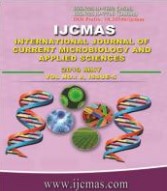


 National Academy of Agricultural Sciences (NAAS)
National Academy of Agricultural Sciences (NAAS)

|
PRINT ISSN : 2319-7692
Online ISSN : 2319-7706 Issues : 12 per year Publisher : Excellent Publishers Email : editorijcmas@gmail.com / submit@ijcmas.com Editor-in-chief: Dr.M.Prakash Index Copernicus ICV 2018: 95.39 NAAS RATING 2020: 5.38 |
Foraging behavior of bumble bees and honey bees with respect to foraging activity, foraging rate, foraging speed, loose pollen grains and abundance were studied by utilization of bumble bees (B. haemorrhoidalis) and European honey bees for the pollination of kiwifruit cv. Allison under caged condition at kiwifruit orchard of Dr. YS Parmar University of Horticulture & Forestry, Nauni, Solan (HP) during 2017. The results revealed that high activity of bumble bees in cage with one colony and cage with two colonies were recorded during 1600-1800hr whereas activity of honey bees was maximum during 1200-1400hr. Bumble bees visited more number of flowers per minute than honey bees, however, honey bees took more time for completing a single foraging trip and spent significantly more time per flower than bumble bee. Peak abundance of bumble bees was recorded at 1600-1800hr and it was between 1200-1400hr for honey bees. Pollination index showed that B. haemorrhoidalis scored higher than A. mellifera. B. haemorrhoidalis carried more number of loose pollen grains adhered to its body as compared to A. mellifera. Number was almost double than that carried by A. mellifera. The present study suggests that bumble bee foragers preferred to visit kiwifruit bloom during morning and evening time than mid-day with more activity, foraging rate and foraging speed during these hours of the day while honey bees preferred mid-day hours with more activity, foraging rate and foraging speed to visit kiwifruit bloom.
 |
 |
 |
 |
 |